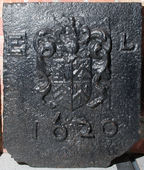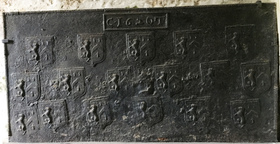-
232
Description: Rectangular shape with bottom corners missing; no edging; central shield, helm, crest and mantling of the Lewis family: quarterly 1st, sable a lion rampant argent (Lewis of Y Fan), 2nd, sable a chevron between three fleurs de lys or (Einon ap Collwyn), 3rd gules three chevronels argent(Iestyn ap Gwrgan), 4th, sable a chevron between three spear heads argent embrued gules (Bleddyn ap Maenyrch); initials split by armorial stamp (’E’ over-stamped); date, formed from single numerals, below arms.
Notes: The arms are those of Sir Edward Lewis, of Van, who purchased St Fagans Castle in 1616. The same armorial stamp was used to model the arms on a lead cistern outside the front door of the castle. It is possible that this fireback was cut down from a larger fireback.
Inscription: E L 1620
Arms: Sir Edward Lewis of Van
- Decoration tags:
- rectangular (shape)
- none (edging)
- carved stamps
- individual letters
- individual numbers
- armorial
- text
Manufactured: in 1620 in the South Wales area of Wales.
Current location: National History Museum, St Fagans, Glamorgan, Wales.
Museum number: 48.354/84 (part of the Welsh National History Museum museum group)
- Attached to series:
- Personal armorial firebacks
- Welsh armorial firebacks
- Bristol armorial group
-
941
Description: Arched rectangular shape; scalloping within wide fillet edging; shield, knight's helm, crest and mantling; date split either side of armorial.
Notes: The arms are of Kyrle (vert, a chevron between three fleurs de lys or; crest: on a mount vert a hedgehog or) of Much Marcle, Herefordshire, quartered with Abrahall (azure three hedgehogs or; the fess appears to be erroneous) and Warnecombe (sable, on a fess dancetty argent between three bezants each charged with an escallop of the field as many lions rampant argent armed and langued gules). The second part of the date appears to have been altered by hand for the present casting as the style of lettering for the final two numerals is crude compared with the first two. Sir John Kyrle may have operated the iron furnace at Whitchurch, between Monmouth and Ross on Wye; the style of the carving is the same as on two other firebacks in the same county. It is apparent, from another example, that this fireback has either been broken and repaired, or deliberately reduced in height. Originally the mantling of the helm extended further down, ending in tassels on each side, making the height of the fireback approximately equal to its width. An early photograph of the Fawley fireback, taken by Alfred Watkins, the Herefordshire antiquarian, shows the division of the two parts more clearly (Herefordshire Record Office, AW339b). A copy of the original, un-reduced fireback has been noted with the date 1685 in the distinctive numerals seen on firebacks from Flaxley Furnace, Gloucestershire.
Copies of this fireback are known.
Inscription: 16 20
Arms: Kyrle quartering Abrahall and Warnecombe
- Decoration tags:
- rectangular with round arch (shape)
- fillet with scalloping (edging)
- whole carved pattern
- individual numbers
- armorial
- text
Manufactured: in 1620 possibly at Whitchurch Furnace in the Herefordshire area of England.
Current location: in private hands, Fawley, Herefordshire, England.
- Attached to series:
- Personal armorial firebacks
- Herefordshire armorial series
-
361
Description: Quasi-rectangular; twisted rope edging on top and sides; cavetto-moulded-edged rectangle top centre, enclosing date between initials; 17 shields of Ayloffe impaling Sulyard in three rows (5-6-6); Ayloffe: sable, a lion rampant Or, collared gules, between three crosses formy of the second; Sulyard: argent, a chevron gules between three pheons inverted sable.
Notes: William Ayloffe (c1535-1584) of Bretons, Hornchurch, Essex, Justice of the Court of Queen’s Bench, married (c1560) Jane, dau. of Sir Eustace Sulyard, of Runwell, Essex. The initials 'CT' are likely to be those of Charles Tyler, a founder whose working life and that of his family have strong parallels with the occurrence of these firebacks.
Inscription: C.1.6 2.0.T
Arms: Ayloffe impaling Sulyard (William Ayloffe of Bretons, Hornchurch)
- Decoration tags:
- rectangular (shape)
- rope (edging)
- carved stamps
- individual letters
- individual numbers
- armorial
- text
Manufactured: in 1620 possibly at Hawkhurst Furnace in the Weald area of England.
Current location: Scotney Castle, Lamberhurst, Kent, England.
Museum number: 791898 (part of the National Trust museum group)
- Attached to series:
- Ayloffe series
- Personal armorial firebacks


